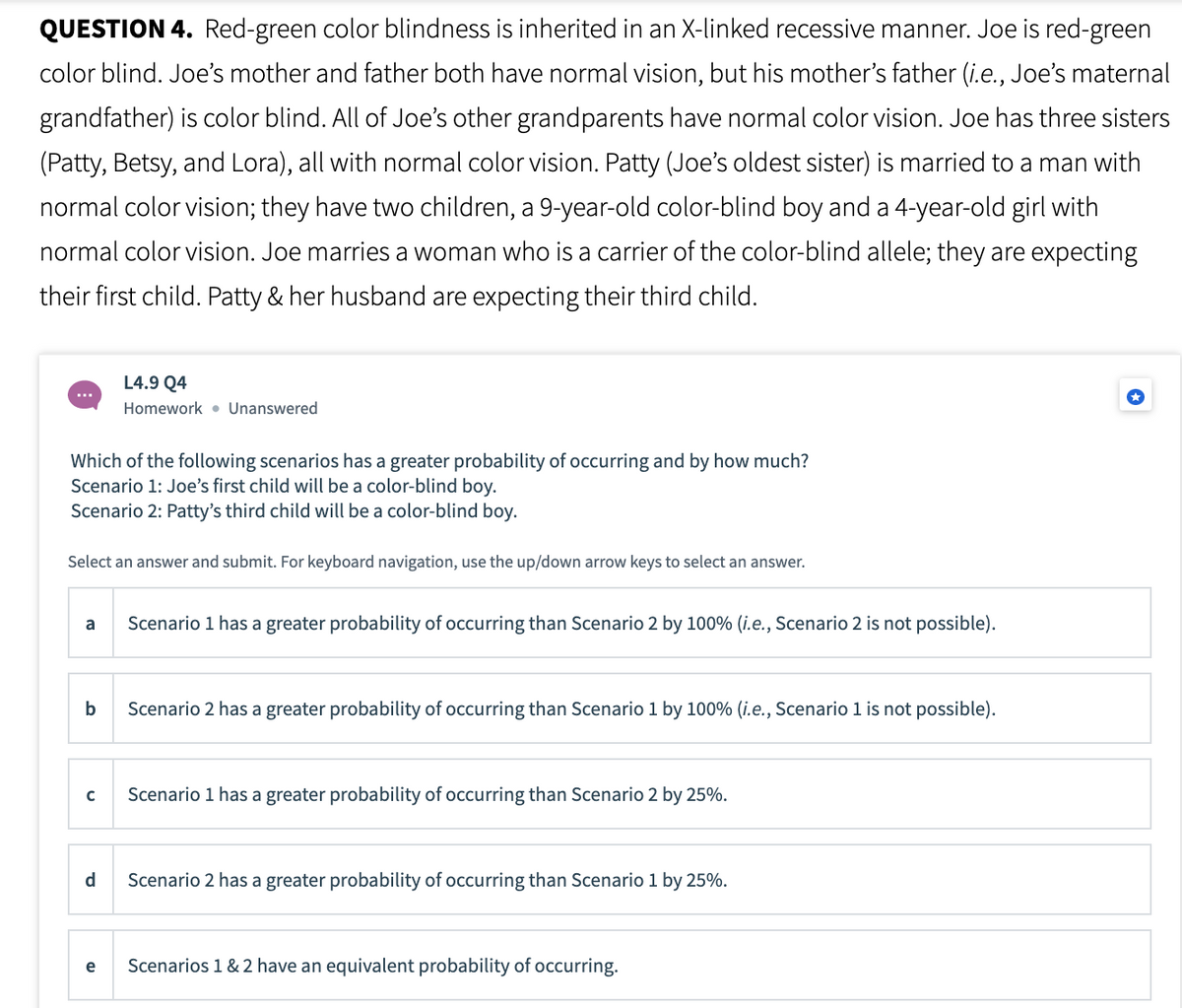QUESTION 4. Red-green color blindness is inherited in an X-linked recessive manner. Joe is red-green color blind. Joe's mother and father both have normal vision, but his mother's father (i.e., Joe's maternal grandfather) is color blind. All of Joe's other grandparents have normal color vision. Joe has three sisters (Patty, Betsy, and Lora), all with normal color vision. Patty (Joe's oldest sister) is married to a man with normal color vision; they have two children, a 9-year-old color-blind boy and a 4-year-old girl with normal color vision. Joe marries a woman who is a carrier of the color-blind allele; they are expecting their first child. Patty & her husband are expecting their third child. L4.9 Q4 Homework • Unanswered Which of the following scenarios has a greater probability of occurring and by how much? Scenario 1: Joe's first child will be a color-blind boy. Scenario 2: Patty's third child will be a color-blind boy.
QUESTION 4. Red-green color blindness is inherited in an X-linked recessive manner. Joe is red-green color blind. Joe's mother and father both have normal vision, but his mother's father (i.e., Joe's maternal grandfather) is color blind. All of Joe's other grandparents have normal color vision. Joe has three sisters (Patty, Betsy, and Lora), all with normal color vision. Patty (Joe's oldest sister) is married to a man with normal color vision; they have two children, a 9-year-old color-blind boy and a 4-year-old girl with normal color vision. Joe marries a woman who is a carrier of the color-blind allele; they are expecting their first child. Patty & her husband are expecting their third child. L4.9 Q4 Homework • Unanswered Which of the following scenarios has a greater probability of occurring and by how much? Scenario 1: Joe's first child will be a color-blind boy. Scenario 2: Patty's third child will be a color-blind boy.
Human Anatomy & Physiology (11th Edition)
11th Edition
ISBN:9780134580999
Author:Elaine N. Marieb, Katja N. Hoehn
Publisher:Elaine N. Marieb, Katja N. Hoehn
Chapter1: The Human Body: An Orientation
Section: Chapter Questions
Problem 1RQ: The correct sequence of levels forming the structural hierarchy is A. (a) organ, organ system,...
Related questions
Topic Video
Question

Transcribed Image Text:QUESTION 4. Red-green color blindness is inherited in an X-linked recessive manner. Joe is red-green
color blind. Joe's mother and father both have normal vision, but his mother's father (i.e., Joe's maternal
grandfather) is color blind. All of Joe's other grandparents have normal color vision. Joe has three sisters
(Patty, Betsy, and Lora), all with normal color vision. Patty (Joe's oldest sister) is married to a man with
normal color vision; they have two children, a 9-year-old color-blind boy and a 4-year-old girl with
normal color vision. Joe marries a woman who is a carrier of the color-blind allele; they are expecting
their first child. Patty & her husband are expecting their third child.
L4.9 Q4
Homework • Unanswered
Which of the following scenarios has a greater probability of occurring and by how much?
Scenario 1: Joe's first child will be a color-blind boy.
Scenario 2: Patty's third child will be a color-blind boy.
Select an answer and submit. For keyboard navigation, use the up/down arrow keys to select an answer.
Scenario 1 has a greater probability of occurring than Scenario 2 by 100% (i.e., Scenario 2 is not possible).
a
b
Scenario 2 has a greater probability of occurring than Scenario 1 by 100% (i.e., Scenario 1 is not possible).
Scenario 1 has a greater probability of occurring than Scenario 2 by 25%.
d
Scenario 2 has a greater probability of occurring than Scenario 1 by 25%.
e
Scenarios 1 & 2 have an equivalent probability of occurring.
Expert Solution
This question has been solved!
Explore an expertly crafted, step-by-step solution for a thorough understanding of key concepts.
This is a popular solution!
Trending now
This is a popular solution!
Step by step
Solved in 4 steps with 2 images

Knowledge Booster
Learn more about
Need a deep-dive on the concept behind this application? Look no further. Learn more about this topic, biology and related others by exploring similar questions and additional content below.Recommended textbooks for you

Human Anatomy & Physiology (11th Edition)
Biology
ISBN:
9780134580999
Author:
Elaine N. Marieb, Katja N. Hoehn
Publisher:
PEARSON

Biology 2e
Biology
ISBN:
9781947172517
Author:
Matthew Douglas, Jung Choi, Mary Ann Clark
Publisher:
OpenStax

Anatomy & Physiology
Biology
ISBN:
9781259398629
Author:
McKinley, Michael P., O'loughlin, Valerie Dean, Bidle, Theresa Stouter
Publisher:
Mcgraw Hill Education,

Human Anatomy & Physiology (11th Edition)
Biology
ISBN:
9780134580999
Author:
Elaine N. Marieb, Katja N. Hoehn
Publisher:
PEARSON

Biology 2e
Biology
ISBN:
9781947172517
Author:
Matthew Douglas, Jung Choi, Mary Ann Clark
Publisher:
OpenStax

Anatomy & Physiology
Biology
ISBN:
9781259398629
Author:
McKinley, Michael P., O'loughlin, Valerie Dean, Bidle, Theresa Stouter
Publisher:
Mcgraw Hill Education,

Molecular Biology of the Cell (Sixth Edition)
Biology
ISBN:
9780815344322
Author:
Bruce Alberts, Alexander D. Johnson, Julian Lewis, David Morgan, Martin Raff, Keith Roberts, Peter Walter
Publisher:
W. W. Norton & Company

Laboratory Manual For Human Anatomy & Physiology
Biology
ISBN:
9781260159363
Author:
Martin, Terry R., Prentice-craver, Cynthia
Publisher:
McGraw-Hill Publishing Co.

Inquiry Into Life (16th Edition)
Biology
ISBN:
9781260231700
Author:
Sylvia S. Mader, Michael Windelspecht
Publisher:
McGraw Hill Education